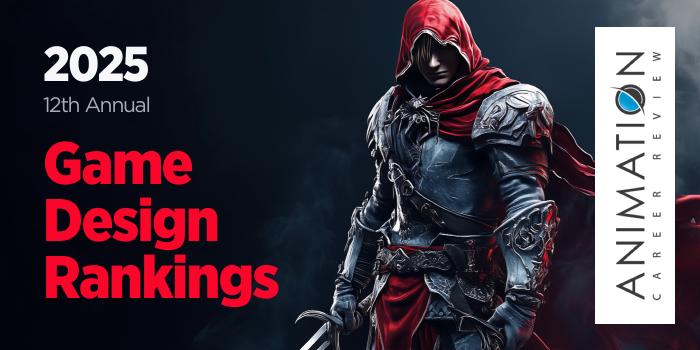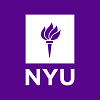
Create your own video games with Unreal Engine or work on the next AAA title! Turn your passion for games into a career with CG Spectrum’s game design, programming and game art courses led by industry pros from major studios. Learn more.

| Ranking | School | City |
|---|---|---|
| 1 | New York University | New York |
| 2 | Rochester Institute of Technology | Rochester |
| 3 | Rensselaer Polytechnic Institute | Troy |
| 4 | The New School | New York |
| 5 | Cornell University | Ithaca |
For an explanation of the ranking criteria, click here.

New York University (NYU) is home to Tisch School of the Arts (NYU Tisch). Founded in 1965 as the School of the Arts, the school was renamed in 1982 after receiving a gift from billionaire brothers and businessmen Laurence A. and Preston Robert Tisch. Today, NYU Tisch provides BA, BFA, MA, MFA, MPS, and PhD degrees in areas such as cinema studies, collaborative arts, film and television, game design, interactive media arts, performance studies, and recorded music.
NYU Tisch also houses the Department of Game Design. Founded in 2008 and known as NYU Game Center, the department hosts workshops, academic seminars, playtests, tournaments, and other events such as NYU Game Center Lecture Series; No Quarter Exhibition (est. 2010); the annual Strategy Guide—Breaking into the Game Industry Workshop; and the professional game conference PRACTICE—Game Design in Detail.
Other NYU Game Center highlights include access to the Clive Davis Institute of Recorded Music; the Game Center Open Library; hands-on experiences in the center’s development studios and play labs; internship opportunities at places such as Blizzard Entertainment, Riot Games, and Disney; and the opportunity to participate in study away programs at NYU’s other campuses in Abu Dhabi and Shanghai, and academic centers in London, Paris, Washington, D.C., Prague, Berlin, Tel Aviv, Buenos Aires, Sydney, Florence, and Madrid.
NYU Game Center students may also participate in The Game Center Incubator. Launched in 2014, the incubator provides expertise, funding, and space for projects with commercial potential. Incubator leaders help select students see projects through to a public launch.
NYU Game Center programs include a BFA, MFA, and minor in Game Design. Single courses are also available for students enrolled in just about any NYU major. Examples include Game Design I-II; 3D Game Studio-Unity; Code Lab; and Game Development-Team Studio.
The NYU Game Center minor is a 16 credit hour program that explores design, production, and the study of games. All students will take Introduction to Game Design or Think Like a Game Designer and at least one of the following four courses: Games 101; Introduction to Programming for Games; Introduction to Games Development; and Introduction to Visual Communication. The remaining credits will come from any other Game Center courses.
Upon completion of the NYU Game Center minor, students are prepared to work in the game industry. Some graduates also go on to become critics or scholars.
The Game Design BFA is a 128 credit hour program with a strong foundation in the liberal arts. This means students will complete a significant amount of coursework in social sciences, humanities, explanatory writing, and hard sciences (biology, chemistry, physics, etc.). BFA students will also explore different styles of creative production by taking a production course in another NYU Tisch department.
The Game Design BFA curriculum consists of primary areas including game design, game development, and game studies, as well as production areas such as programming, visual design, game business, and audio design. Course examples for the program include Introduction to Game Design; Level Design Studio; 3D Development; Modern Tabletop Literacy; Pixel Prototype; The Immersive SIM; Programming for Games; 3D Modeling for Games; Art Direction for Games; XR Studio; Music and Gameplay; Games in Narrative; Shade Lab; Roleplaying on the Margins; 2D Animation for Games; and Business of Video Games.
The Game Design BFA program at NYU culminates with the Senior Capstone. This final project can be a group or solo game, curated exhibition, or research paper—student’s choice.
The NYU Game Center MFA is a two-year program that consists of coursework in game history, game design, game studies, game production, game studio, and play labs. Students will also select a number of electives that support their interests and goals. The first semester of the program is structured to include Game Design 1; Code Lab 0; Games 101; Game Studio 1; and Visual Lab 0. The second semester is more flexible, so students will take just two required courses—Game Studies 1 and Game Studio—along with their chosen electives.
Examples include Intermediate Programming for Games; Prototype Studio; 3D Game Studio-Unity; Shader Lab; Tech Art Studio; Tackling Representation in Games; Horror Games; American Computer Games of the 1980s; UI/UX for Games; Mobile Game Studio; and Survival Skills.
The Game Design MFA program at NYU culminates with a thesis, completed across two courses (12 credit hours). Thesis projects may be completed individually or in teams. Examples of possible projects include a series of small games, a sport, digital games, or card games. MFA projects will be presented at the NYU Game Center Spring Show.
NYU Game Center BFA and MFA graduates will enter the job market with a resume, several finished games or related works, and the assistance of NYU’s extensive Wasserman Career Center. As part of Tisch School of the Arts, NYU Game Center graduates also have access to the school’s own Office of Career Development, which helps alumni launch their creative careers.
Across programs, graduates are prepared to pursue advanced roles in all areas of games. Program alumni have been hired at places such as Blizzard Entertainment, Riot Games, Disney, Nickelodeon, ESPN, Amazon, Tencent Holdings, Avalanche Studios Group, Take-Two Interactive Software, Arkadium Games, and the International Game Developers Association Japan (IGDA Japan).
Some NYU Game Center alumni have also gone on to launch their own studios, write books, organize festivals, and win awards.
New York University is the largest private university in the U.S. Founded in 1831, the school serves more than 55,000 students across degree-granting campuses in New York, Abu Dhabi, and Shanghai. With more than 19,000 employees, New York University is also one of the state’s largest employers.
Students at NYU have access to more than 400 program options across 20+ colleges, schools, and institutes. New York University is accredited by the Middle States Commission on Higher Education (MSCHE).

Rochester Institute of Technology (RIT) has a long history of firsts. In 1983, RIT became the first university in the nation to provide a BS in Biotechnology. In 1990 the school became the first in the U.S. to launch an Imaging Science PhD program. And in 1996, RIT became America’s first university to house a bachelor’s degree in Software Engineering.
In 2016, Rochester Institute of Technology also became the first university in the world to publish a video game on the Xbox One gaming platform. Today, RIT houses the B. Thomas Golisano College of Computing and Information Sciences (GCCIS)—home to the School of Interactive Games and Media (IGM). Within the school are several paths to study game design including BS and MS degrees in Game Design and Development (GDD); an accelerated BS/MS that takes just five years to complete instead of six, and minors in Game Design and GDD.
The College of Art and Design at RIT has an additional path to study games. Housed in the college’s School of Design, the 3D Digital Design BFA is a STEM-designated program with specializations in Game Arts and 3D Visualization.
Across programs, students benefit from up to two paid blocks of cooperative education experiences with places such as Epic Games, Electronic Arts (EA), Sony Interactive Entertainment, Microsoft, Cartoon Network, and Google; access to game development and research studios; independent study opportunities; lectures, workshops, seminars, and demonstrations by industry professionals; Creative Industry Days; and access to the Digital Games Hub.
Creative Industry Days is a series of networking events with major companies and studios, where students can engage in panel discussions and portfolio reviews. Examples of past participating companies include Walt Disney, Epic Games, Adobe, Ogilvy, DraftKings, Iron Galaxy Studios, Enduring Games, NetherRealm Studios, Zash Global Media & Entertainment, MahiGaming, and CGI Digital.
The Digital Games Hub provides mentoring and resources for students and independent developers to create new games, launch start-ups, and enter the games industry.
RIT IGM GDD students also have the opportunity to develop and commercialize their own games at RIT’s MAGIC Spell Studios. With support from the Epic MegaGrants program, this state-of-the-art facility houses a 7,000 square feet sound stage; several media labs; 32’ x 16’ LED wall, with technical support for motion capture, camera tracking, the virtual art department, and real-time in-camera visual effects; a 4K Dolby Atmos theater; post-production sound mixing and color correction suites; a green room; hair/makeup/shower facilities; and production offices.
The GDD degree programs at RIT explore game design and development, modeling, animation, interactive media, science, user interaction, and math. The BS consists of 121 credit hours; the MS requires 33 credits; and the BS/MS is 145 total credit hours.
Students in the BS have opportunities to specialize in areas such as narrative, engines, audio, or graphics through electives across the entire university. Course examples for the program include Interaction, Immersion, and the Media Interface; Game Design and Development I-II; Introduction to Web Technology for Game Developers; and Data Structures and Algorithms for Games and Simulation I-II.
RIT GDD BS students may also complete approximately 40 credit hours of open, advanced, and general education electives. Examples of advanced electives include Vertically Integrated Projects (VIP) for Computing I-II; Games for Change; Level Design 1-2; IGM Production Studio; Artificial Intelligence for Game Environments; Digital Audio Production; Casual Game Development; Theory and Design of Role Play and Interactive Narrative; Game Graphics Programming I-II; and Game Development Processes.
The GDD BS program culminates with a final project and presentation. Graduates are prepared to pursue careers in industries such as game design and development, animation, film and television, aerospace, internet and software, defense, media and publishing, computer hardware, education, science, and health.
The Game Design and Development MS is a cohort-based program designed for students seeking careers in the games industry, visualization, simulation, or edutainment. Course examples include Game Design; Gameplay and Prototyping; Game Development Process; Colloquium in Game Design and Development; and Game Industry Themes and Perspectives.
Advanced elective examples include Console Development; Graduate Seminar in IGM; Global Illumination; Advanced Topics in Game Design; Vertically Integrated Projects (VIP) for Computing – Graduate; Applied Perception in Graphics and Visualization; Game Design and Development for Casual and Mobile Platforms; and Research Methods: Human-Centered Research in Games; and Computer Animation: Algorithms and Techniques.
The GDD MS program at Rochester Institute of Technology culminates with a capstone project completed across the 700-level Capstone Design and Capstone Development courses. Graduates are prepared to pursue advanced roles in game design and development, software engineering, computer hardware, aerospace, defense, systems design, graphics automation engineering, animation, film and television, internet and software, media and publishing, education, health, and science, among others.
The Game Design and GDD minors at Rochester Institute of Technology require 15 credit hours. Students in both options will complete Game Design and Development I-II. Other course examples include New Media Interactive Design and Algorithmic Problem Solving I-II; 2D Animation and Asset Production; Data Structures for Games and Simulations I-II; and Interactive Media Development.
Across all Game Design and Development programs, graduates have been hired at major companies and studios such as Rockstar Games, Sony Interactive Entertainment, Electronic Arts (EA), Microsoft, and Epic Games.
The 3D Digital Design BFA at Rochester Institute of Technology requires 120 credit hours. Both the Game Arts and 3D Visualization specializations allow students to study games. Students in both programs will take courses such as Modeling and Motion Strategies; 2D, 3D and 4D Design; Layers and Effects; Anatomical Frameworks for 2D and 3D Applications; Layers and Effects; and Scripting.
Game Art students will take other courses such as Digital Illustration; The History of Game Arts; Game Design and Development I-II; Contemporary Practices – Technology in Game Arts; and IGM Production Studio. Examples of Game Art-specific electives include Principles of Animation; Fantastic Illustration; Zoological and Botanical Illustration; 2D/3D Pre-Visual World Building; and Drawing for Animation.
Visualization students also have access to programming electives such as Game Development and Algorithmic Problem Solving I; Software Development and Problem Solving; Computer Science I; Computational Problem Solving for Engineers; and Principles of Computing.
All 3D Digital Design students have access to electives such as Simulating Natural Phenomena; Character Design and Rigging; Real Time Design; 3D Motion Graphics; Experimental Workshop; and Physical Interface Design.
The 3D Digital Design program at Rochester Institute of Technology culminates with the Senior Capstone completed across two courses. Game Art students will also complete Contemporary Practices: Technology in Game Arts to graduate. All finished projects will be submitted to competitions, integrated into student portfolios, and presented at the Senior Capstone Show.
Graduates of the 3D Digital Design BFA program at RIT are prepared to pursue titles such as Game Designer, Rigger, CG Artist, Character Designer, Game Developer, AR/VR Designer, Visualization Artist, Digital Asset Designer, Level Designer, Special Effects Artist, Lighting Technical Director, and Environment Designer. Program alumni have been hired by major game studios such as Sony Interactive Entertainment and Insomniac Games.
Rochester Institute of Technology was founded in 1829 as the Rochester Athenaeum. With global campuses in China, Croatia, Dubai, and Kosovo, this research university serves more than 20,000 students, making it one of the largest private universities in the U.S. RIT provides 200+ academic programs across 10 colleges and institutes, and the School of Individualized Study. Rochester Institute of Technology is accredited by the Middle States Commission on Higher Education (MSCHE).

Rensselaer Polytechnic Institute (RPI) is home to the Houdini Certified School of Humanities, Arts, and Social Sciences (HASS). The school houses the Departments of Communication and Media; Arts; Science and Technology Studies; Economics; Cognitive Science; and Games and Simulation Arts and Sciences (GSAS). Across departments, HASS students have opportunities to enroll in a dual major and work with peers, accomplished faculty members, and professionals in engineering, business, science, architecture, and more.
The GSAS Department at RPI houses the GSAS BS and Critical Game Design (CGDS) MS and PhD programs. The GSAS also leads the Center of Excellence in Digital Game Development. Funded by the Division of Science, Technology, and Innovation (NYSTAR) in New York’s Empire State Development Department, the RPI Center of Excellence hosts trade shows and conferences such as the Game Developers Conference (GDC) in San Francisco; the annual student games showcase and research symposium known as GameFest; and Ripcord, a joint blog-and-podcast series that focuses on games.
The Center also hosts lectures and technical workshops; game jams and hackathons; STEAM educational programs; research in games-related fields such as game AI, wargaming, historical simulations, and virtual reality; an intensive, yearlong games incubator known as the Level Upstate Mentorship Program; and training activities for gaming startups.
GSAS BS and CGDS graduate students have access to everything the Center of Excellence in Digital Game Development has to offer. All programs are interdisciplinary, allowing students to explore experimental game design; software engineering; 3D animation; programming; digital arts; and music and audio for games.
The GSAS BS has six concentrations including Computer Science; Electronic Arts; Writing; Cognitive Science; Music; and Management. Students have the opportunity to build a number of professional games throughout the program and a professional internship. Graduate students will complete research projects and game prototypes. All students may participate in study away programs such as the semester abroad in Singapore at Nanyang Technological University.
Graduates of the GSAS BS and CGDS programs at Rensselaer Polytechnic Institute are prepared to pursue careers in fields such as game design and development, artificial intelligence (AI), visualization, animation, software development, interactive simulation, and fine arts. CGDS graduates are also prepared to conduct research and teach at the university level or pursue leadership roles in the games industry as consultants, directors, producers, and entrepreneurs.
RPI alumni have been hired at places such as Walt Disney, Hasbro, DreamWorks Animation, Lockheed Martin, Microsoft, Apple, Boeing, Adobe, Google, IBM, Amazon, Red Hat, LG, Pratt & Whitney, Dell, Meta, HP, Broadcom, Cruise, Tetra Tech, SAS Institute, and Boston Scientific.
Established in 1824, Rensselaer Polytechnic Institute is the nation’s first technological research university. Serving approximately 6,970 students, RPI provides more than 145 undergraduate, graduate, and doctoral programs across five schools. Rensselaer Polytechnic Institute is accredited by the Middle States Commission on Higher Education (MCSHE) and the Accreditation Board for Engineering and Technology (ABET).

The New School houses Parsons School of Design (Parsons). Serving more than 5,700 students, Parsons is The New School’s largest school. For game designers, Parsons provides a Design and Technology (DT) program with BFA and MFA options. Programs are interdisciplinary and STEM-designated, with studios and lab courses led by experts in the field.
Other program features include industry internships; collaborations between artists and designers across The New School; networking opportunities and sponsored projects with external partners; and study abroad experiences in places such as Florence, Paris, and London.
The Parsons DT BFA is a 120 credit hour program that explores media storytelling, emerging art and design practices, and interaction technologies. Two paths are available including Game Design and Creative Technology. Game Design students will work on original projects that explore socially conscious video games, wearable technology, and digital art. Creative Technology students will tour and work on projects with major companies and studios such as Nickelodeon, Atari, MTV, Apple, Rockwell Interaction Lab, and UNESCO.
Students in both paths have access to courses such as Creative Coding; Digital Asset Creation 2D and 3D; Game Design as Play Design; Environments; Anatomy and Perspective for Visual Storytellers; CG 1 and 2; Interaction Studio; Motion Graphics; Experimental Animation; Drawing/Imaging; Communication Design Studio: JavaScript; Physical Computing; Communication Design Foundations-Interaction; Data Visualization and Information Aesthetics; Web Design; Light and Image; and Critical Computation Lab.
In the fourth year of the DT BFA program, students will complete a thesis project. The Pro Launch Studio course prepares students for careers in the industry.
The DT MFA at Parsons School of Design is a studio-based program that explores game design, new media art, interaction design, physical computing, critical design, wearable technology, and data visualization. In addition to seminars, labs, and electives across Parsons and The New School, MFA students will complete Collaboration Studio and Thesis Studio courses.
In Collaboration Studio courses, students will work with partner companies on real-world projects. Examples of past partners include NASA, Intel, Mozilla, Samsung, The Met, Samsung, One Plus, Ralph Lauren, the Whitney Museum of American Art, and Red Bull. Projects explore areas such as game design, film and video, audiovisual performance, and web and mobile apps.
Other program features include the Cloud Salon Series (CSS) and access to state-of-the-art facilities and labs. The CSS is a webinar series consisting of fine artists, designers, technologists, and other industry professionals. Past speakers have included Yuri Suzuki, New Red Order, Lauren Lee McCarthy, Zach Lieberman, and Audrey Bennett.
Graduates of the Design and Technology programs at The New School are prepared to pursue leadership roles across the game design, entertainment, advertising, and web design industries, among others. New School alumni have been hired at major companies and studios across the U.S. and abroad.
The New School was founded in 1919 as the New School for Social Research. Serving approximately 10,815 students today, the school provides nearly 130 degree and diploma programs across six colleges and schools. This includes Parsons School of Design; Eugene Lang College of Liberal Arts; the College of Performing Arts; The New School for Social Research; the Schools of Public Engagement; and Parsons Paris.
The New School has been accredited by the Middle States Commission on Higher Education (MSCHE) since 1960. Parsons Paris is declared to the Rectorat de Paris as an établissement d’enseignement supérieur privé (a private higher education establishment) and has maintained its right to operate in France since 2013. This branch campus of The New School is also MSCHE-accredited.

The Game Design Initiative at Cornell University (GDIAC) launched in 2001, making it one of the first computer game programs of its kind, and the first established at an Ivy League School. Hosted within the Cornell Bowers College of Computing and Information Sciences’ (CIS) Department of Computer Science, this interdisciplinary program provides a Game Design minor available to students in all colleges and majors. Consisting of 18 credit hours (minimum), the minor focuses on project-based learning and a curriculum that emphasizes gameplay design, game analytics, software development, and project management.
Required courses for the program include Analytics Driven Game Design; Introduction to Computer Architecture/Design; and Advanced Topics in Computer Game Architecture/Design. Students will choose four courses from Art, Computer Science, Information Science, Music, Performing and Media Arts, and Psychology.
Across areas, ideal courses for game designers include Novel Interaction Techniques; Interactive Computer Graphics; Creative Character Design; Screenwriting; Graphics and Art; Natural Language Processing; Advanced Human-Computer Interaction Design; Psychology of Gaming; Rapid Prototyping and Physical Computing; Foundations of Artificial Intelligence; Object-Oriented Programming and Data Structures; New Media and Society; Sound Design; and Machine Learning for Intelligent Systems.
Students may select courses from other departments, such as Game Studies and Japan; Human Factors and Inclusive Design; and History and Theory of Digital Art from other departments on a petition basis.
While the GDIAC Game Design minor is open to all Cornell students, it is ideal for students in the CS BS program. Examples of CS courses related to games include Algorithmic Game Theory; Advanced Topics in Computer Game Architecture; Cloud Computing; and Machine Learning.
All CS students also have the opportunity to complete a professional internship and participate in any one of Cornell’s study abroad (SA) programs. The school’s portfolio of SA options includes Cornell Global Hubs with locations such as India, Ghana, Denmark, and China; short-term study in places such as the UK, Madrid, and Paris; and semester- or year-long study dozens of different locations.
The Game Design minor culminates with a final project. Students may work in teams or solo to complete the project, which can be a PC, mobile, or other game. Final projects may be entered into the annual GDIAC Showcase.
Graduates of the CS/Game minor program are prepared to pursue advanced roles in the gaming, technology, architecture, aerospace, science and medicine, legal, education, advertising and marketing, and business industries, among others.
Cornell University alumni enjoy a 99% success rate shortly after graduating. Some of the top employers for Cornell Game Design and CS graduates include Nintendo, Electronic Arts (EA), Blizzard Entertainment, PlayStation, Naught Dog, Epic Systems, Hulu, Riot Games, Zynga, Oracle, Microsoft, Apple, IBM, Bethesda, Amazon, Valve Corporation, Dell, Google, Tencent, Meta, Twitter, and Snapchat.
Founded in 1865, Cornell University is the youngest of the eight Ivy League Universities. A federal land-grant institution, the school serves approximately 26,795 students enrolled in more than 300 majors, minors, and graduate fields of study across 16 colleges and schools. In addition to the main campus in Ithaca, New York, Cornell has campuses in Geneva, New York; New York, New York; Washington, D.C.; Rome, Italy; and Doha, Qatar. Cornell University has been accredited by the Middle States Commission on Higher Education (MSCHE) since 1921.